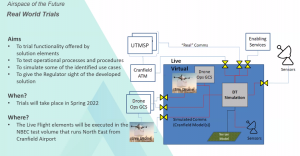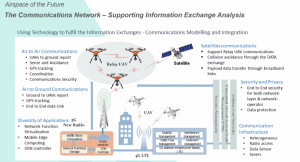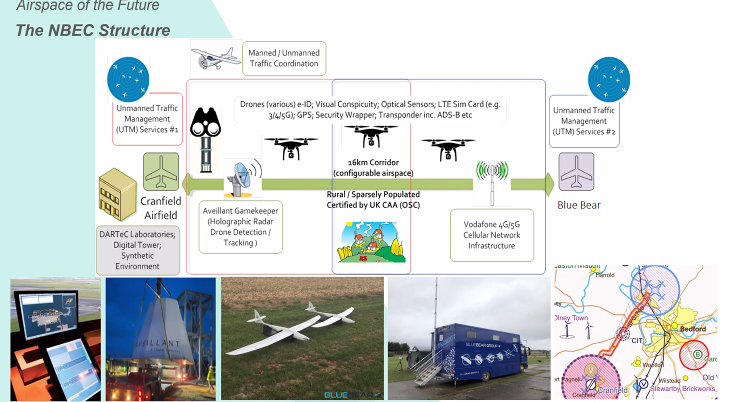By Jenny Beechener
The Airspace of the Future project starts live trials in Spring 2022 in the UK National Beyond visual line of sight Experimentation Corridor (NBEC) that extends from Cranfield Airport to Oakley in Bedfordshire. The project is financed by the UK Research and Innovation (UKRI) Future Flight Challenge programme and aims to enable drones to transition from visual line of sight (VLOS) to beyond visual line of sight (BVLOS) operations by 2030.
“The project will cover advanced U2 and U3 level U-space services,” explained Phil Vernall, Thales System Architect during the Connected Places Catapult webinar on 17 November 2021. Thales leads a consortium of nine UK companies developing solutions for the safe integration of unmanned aerial systems (UAS) into controlled airspace and examining ways to support reliable information exchange, surveillance, navigation and de-confliction issues. By focusing on three use cases: Inspection services, blue light operations, and light goods services, the project will also demonstrate the business case for BVLOS operations.
“The CORUS concept of operations is the most advanced set of recommendations and forms the basis of this programme. We expect to develop a blueprint for the enterprise architecture and demonstrate use cases,” said Phil Vernall.
The enterprise architecture is taking shape in the form of a digital twin. This provides an accurate digital representation of the real environment including the ground infrastructure, airspace and weather, communications, unmanned and manned airspace users. This synthetic environment will be combined with real live operations in 2022 to test the operational processes and procedures in a series of flights currently in planning stage.

Cranfield University is examining how to leverage and optimise the communications infrastructure – including 5G – to provide resilient and secure interactions, and Altitude Angel is responsible for providing its Unmanned Traffic Management (UTM) platform that will allow “fair and equitable access to the airspace”. BlueBear began using the test corridor in 2019 to evaluate drone services including Automatic Dependent Surveillance – Broadcast (ADS-B) in support of routine operational drone services, and consortium member Ocado will investigate carriage of light payloads of under 3kg as part of plans to expands its national and international delivery services.

Project partners expect to validate BVLOS operations based on a robust business case and identify challenges facing the industry. Among these, societal acceptance of drone operations, security, scalability, and airspace deconfliction are considered in the project. “Detect and avoid is the elephant in room,” said Phil Vernall. Whether this is carried out on the platform, or via a remote system, it needs to be part of the enterprise architecture.”
The Airspace of the Future (AoF) consortium is made up of nine UK organisations – Altitude Angel, Thales, Cranfield University, Cranfield Airport Operations, Inmarsat, Ocado Group, Blue Bear, Satellite Applications Catapult, and Connected Places Catapult.
For more information visit:




